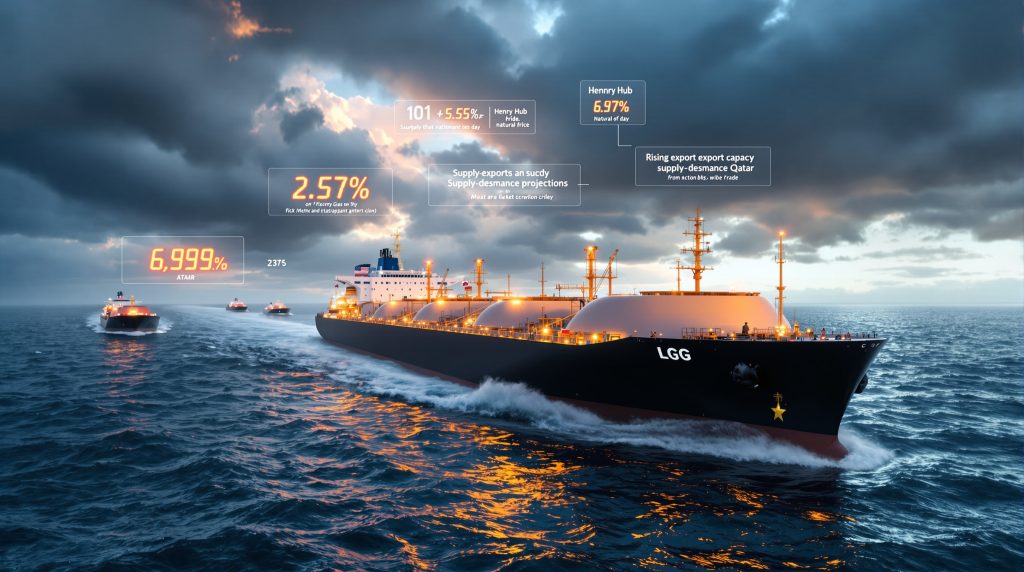What's Driving the U.S. LNG Export Surge?
The American liquefied natural gas (LNG) sector is experiencing unprecedented expansion, fueled by a perfect storm of favorable conditions. Abundant domestic shale gas production has provided a strong foundation, while policy support from the Trump Administration has created a conducive regulatory environment. The 2025 lifting of the temporary pause on new LNG project approvals has unleashed a wave of investment decisions that are reshaping the global energy landscape.
International demand, particularly from Europe as it works to eliminate Russian gas imports by January 2027, continues to provide a strong market for U.S. exports. This combination of factors has positioned the United States as the dominant force in global LNG development, accounting for 95% of all newly sanctioned capacity in 2025.
Major projects receiving final investment decisions (FIDs) in 2025 include Woodside's Louisiana LNG, Venture Global's CP2 LNG with its associated $15.1 billion project financing, and Cheniere's Corpus Christi expansion. Upon completion, the Corpus Christi LNG terminal alone is expected to exceed 30 million tonnes per annum (mtpa) in total liquefaction capacity later this decade.
However, this dramatic growth trajectory faces significant headwinds as the global market approaches what many industry analysts describe as an inevitable U.S. LNG export boom oversupply condition.
How Big Will the Global LNG Oversupply Be?
The Scale of Capacity Expansion
The global LNG market is heading toward what the International Energy Agency (IEA) describes as "the largest capacity wave in any comparable period in the history of LNG markets." Between 2025 and 2030, nearly 300 billion cubic meters per year of new export capacity is expected to come online from projects already under construction or with final investment decisions.
This massive growth is primarily driven by two powerhouse producers:
| Country | Contribution to New Capacity | Key Projects |
|---|---|---|
| United States | Approximately 95% of newly sanctioned capacity in 2025 | Louisiana LNG, CP2 LNG, Corpus Christi expansion |
| Qatar | Major expansion program | North Field East and North Field South projects (completion by 2027) |
| Other | Limited new capacity | Argentina's single FID project in 2025 |
Notably, these projections exclude Russia's heavily sanctioned Arctic LNG 2 project, which has started shipping fuel to China despite international restrictions.
Projected Market Imbalance
According to market analysis from LSEG cited by Reuters, the supply-demand balance is expected to shift dramatically in the coming years:
- 2025: Relatively balanced market conditions
- 2026: Projected oversupply of approximately 50 billion cubic meters
- 2030: Potential oversupply reaching 200 billion cubic meters (four times larger than 2026)
This looming oversupply threatens to significantly depress global LNG prices and compress profit margins for exporters, with U.S. producers potentially feeling the squeeze more acutely due to their higher cost structures compared to some international competitors like Qatar.
What Challenges Will U.S. LNG Exporters Face?
International Market Pressures
The U.S. LNG export industry faces multiple external challenges that could impact profitability and long-term viability:
-
Price Compression: As global supply outpaces demand, LNG prices will likely fall, potentially narrowing the price differentials between U.S. domestic gas and international LNG markets that have historically driven export economics.
-
Competition from Low-Cost Producers: Qatar's expansion will introduce significant volumes of low-cost LNG to the market, potentially undercutting U.S. suppliers in price-sensitive markets, particularly in Asia.
-
Uncertain Demand Growth: While European demand remains strong during its transition away from Russian pipeline gas, Asian demand growth has proven more volatile, influenced by economic conditions, weather patterns, and price sensitivity.
Domestic Competition for Natural Gas Resources
U.S. LNG exporters are also confronting growing competition for domestic natural gas resources:
-
Rising Power Sector Demand: The proliferation of data centers and AI infrastructure is driving substantial growth in electricity consumption, with natural gas expected to fuel a significant portion of this increased generation.
-
Manufacturing Resurgence: The onshoring of manufacturing activities is creating additional domestic gas demand, further tightening the U.S. gas market.
-
Price Effects: The Energy Information Administration (EIA) forecasts that the Henry Hub natural gas spot price will rise from approximately $2.91/MMBtu in August 2025 to $3.70/MMBtu in the fourth quarter, and further to $4.30/MMBtu in 2026, reflecting tightening domestic supply-demand dynamics.
These rising domestic prices could potentially squeeze export margins from both sides—higher input costs domestically and lower selling prices internationally. The US natural gas forecast indicates this trend will continue as demand growth outpaces production increases.
Will U.S. LNG Projects Remain Viable Despite Oversupply Risks?
Despite the challenges outlined above, U.S. LNG projects continue to attract substantial investment interest. According to Wood Mackenzie analysts, "U.S. LNG is still one of the hottest investments in energy" despite emerging oversupply risks. Several factors support their ongoing viability:
Strengths of U.S. LNG in a Competitive Market
-
Contract Structure: Many U.S. LNG export facilities operate under long-term contracts that provide revenue stability regardless of spot market conditions, offering protection against temporary price downturns.
-
Flexibility Advantage: U.S. LNG contracts typically offer destination flexibility, making them attractive to buyers seeking supply security with optionality—a competitive advantage over more restrictive contract structures from other suppliers.
-
Geopolitical Diversification: Many buyers value U.S. LNG as part of a strategy to diversify supply sources, reducing dependence on any single region for energy security reasons.
-
Abundant Feedstock: The continued productivity of U.S. shale gas fields provides a reliable and potentially expandable supply base, underpinning confidence in long-term export capabilities.
Investment Outlook
Despite oversupply concerns, U.S. LNG remains an attractive investment proposition for several reasons:
-
Growing Global Demand: While temporary oversupply is likely, long-term global LNG demand is projected to continue growing, particularly as more countries transition away from coal for power generation and industrial use.
-
European Pivot: Europe's commitment to eliminate Russian gas imports by January 2027 creates a substantial and relatively secure market for U.S. LNG, providing a base level of demand.
-
Capital Availability: According to Wood Mackenzie, "a growing number of investors want a slice of America's LNG, which is broadening access to a deepening pool of capital" for project development.
The fundamental case for U.S. LNG export boom oversupply remains strong, supported by ample domestic supply, growing global demand, and favorable policy support. Recent Alaska drilling policy changes may further support domestic production capacity.
How Will the LNG Boom Impact U.S. Natural Gas Producers?
The expansion of LNG exports creates both opportunities and challenges for domestic natural gas producers:
Positive Market Effects
-
Price Support: Increased export volumes are expected to provide support for domestic natural gas prices, benefiting producers who have struggled with low prices in recent years.
-
Production Incentives: Higher prices should incentivize increased production, potentially opening new development opportunities in gas-rich basins including the Appalachian Basin, Haynesville Shale, and Permian Basin associated gas production.
-
Dual Demand Growth: Producers will benefit from rising demand from both LNG exports and increased domestic power generation, creating a more diversified customer base.
Market Dynamics
The EIA forecasts that Henry Hub natural gas prices will rise significantly through 2026, driven by:
- Relatively flat production growth in the near term
- Rising export volumes
- Increasing domestic consumption
This price environment could trigger a new wave of drilling activity, particularly in the most productive shale gas regions. Natural gas producers face a win-win scenario, with demand for their output coming from both increased domestic gas-fired power generation and rising LNG exports.
What Are the Long-Term Prospects for U.S. LNG Exports?
Looking beyond the potential oversupply period, several factors will influence the long-term trajectory of U.S. LNG exports:
Global Energy Transition Factors
-
Role in Decarbonization: Natural gas, including LNG, is widely viewed as a transition fuel that can support decarbonization efforts by displacing coal while renewable energy scales up.
-
Competition from Renewables: The accelerating deployment of renewable energy globally could eventually limit LNG demand growth, particularly in price-sensitive markets.
-
Carbon Intensity: The carbon footprint of LNG production and transportation is receiving increasing scrutiny, potentially affecting market access in regions with strict emissions policies.
Competitive Positioning
U.S. LNG will need to navigate several competitive challenges in the long term:
-
Cost Structure: While U.S. projects benefit from existing infrastructure and regulatory certainty, they typically have higher production costs than some competitors, particularly Qatar.
-
Supply Chain Resilience: The industry's ability to maintain reliable operations through potential supply chain disruptions will influence buyer confidence.
-
Technological Innovation: Developments in areas such as carbon capture and storage could significantly impact the competitive positioning of different LNG sources, potentially creating both challenges and opportunities for U.S. producers.
The critical minerals transition and raw materials green shift will also influence how natural gas fits into future energy systems as countries balance decarbonization goals with energy security needs.
FAQ: U.S. LNG Export Market Outlook
How will the global LNG oversupply affect U.S. export prices?
The projected oversupply could significantly depress global LNG prices, potentially narrowing the spread between U.S. domestic gas prices and international LNG prices. This price compression would reduce profit margins for U.S. exporters, particularly those without long-term contracts at fixed prices.
Can U.S. LNG compete with Qatar's expansion in international markets?
While Qatar benefits from lower production costs, U.S. LNG offers advantages in contract flexibility, supply security, and geopolitical diversification that remain attractive to many buyers. The competitive dynamics will likely vary by market, with U.S. LNG maintaining strength in Europe while facing tougher competition in price-sensitive Asian markets.
How will rising domestic gas demand affect the LNG export industry?
Increasing domestic demand, particularly from power generation for data centers and manufacturing, will create competition for gas resources and likely push domestic prices higher. This could potentially constrain export growth if domestic prices rise to levels that make exports uneconomical under certain market conditions.
What impact will the oversupply have on future LNG project development?
The projected oversupply may lead to delays or cancellations of some proposed LNG projects that have not yet reached FID. Developers will likely become more selective, prioritizing projects with the strongest economics, secured long-term contracts, and strategic advantages in accessing key markets.
Conclusion: Balancing Opportunity and Risk in the U.S. LNG Sector
The U.S. LNG export boom oversupply represents one of the most significant developments in global energy markets in recent decades. While the industry faces potential challenges from oversupply and domestic competition for gas resources, the fundamental drivers supporting continued growth remain strong.
The coming years will likely see a period of adjustment as the market absorbs the substantial new capacity coming online. U.S. exporters with strong contract positions, operational efficiency, and strategic market access will be best positioned to weather potential oversupply conditions while maintaining long-term viability.
For natural gas producers, the export boom creates valuable demand growth that should support prices and incentivize production increases. The dual growth drivers of exports and domestic consumption provide a more diversified demand base than the industry has historically enjoyed.
While oversupply risks are real and warrant careful consideration by investors and project developers, the long-term outlook for U.S. LNG exports remains fundamentally positive, supported by global energy transition needs, Europe's pivot away from Russian gas, and the continued productivity of America's vast natural gas resources. Current oil price rally analysis shows energy markets remain volatile, further emphasizing the importance of diversified energy sources.
Want to Stay Ahead of Major Mineral Discoveries?
Discover significant ASX mineral announcements before the market with Discovery Alert's proprietary Discovery IQ model, turning complex data into actionable investment insights. Visit the Discovery Alert discoveries page to understand how major mineral discoveries can lead to substantial market returns and start your 30-day free trial today.




